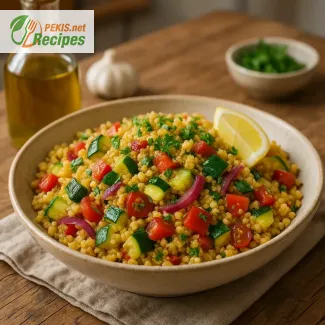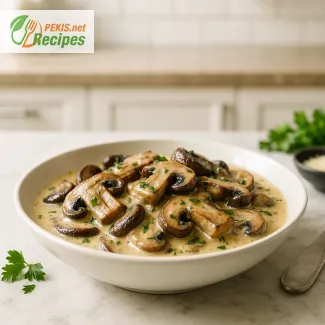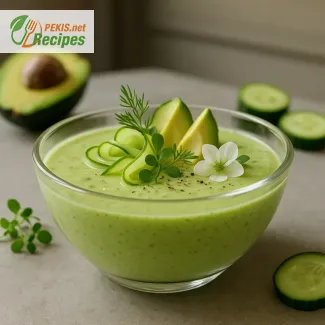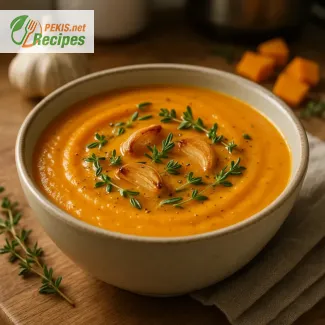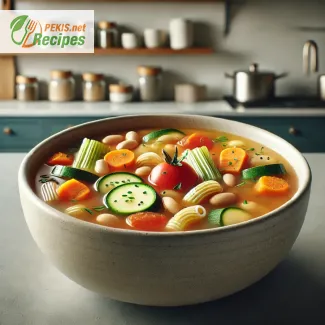
Minestrone Soup with Vegetables is a vibrant, hearty Italian soup known for its delightful blend of fresh seasonal vegetables, herbs, beans, and often pasta or rice. This traditional dish showcases Italy's love for simple yet flavorful ingredients, creating a soul-warming meal that feels both comforting and nourishing. Originating from peasant kitchens, minestrone was once considered a "poor man’s meal," yet over centuries, it has evolved into an iconic representation of Italian cuisine that is celebrated globally.
What Minestrone Soup is Used For
Minestrone soup is highly versatile and can be enjoyed in several ways. It’s ideal as an appetizer or main course, especially in colder months when a warm bowl of soup is most inviting. Packed with fiber, vitamins, and minerals from an array of vegetables, it’s a nutrient-dense choice that aligns well with balanced diets, vegetarian lifestyles, and even vegan preferences if cheese is omitted. It’s commonly used for:
- Boosting Immunity: Rich in antioxidants from ingredients like tomatoes, carrots, and greens, minestrone soup strengthens immune defenses.
- Promoting Digestion: With a good amount of fiber from beans and vegetables, it supports healthy digestion.
- Sustaining Energy: Beans and pasta or rice provide complex carbohydrates and proteins, making it ideal for sustained energy.
- Heart Health: Often made with olive oil, a healthy fat, and an assortment of vegetables, it supports cardiovascular wellness.
This soup adapts well to any season because it allows you to use locally grown produce that is fresh and flavorful. In winter, root vegetables, cabbage, and kale make hearty substitutes, while in spring and summer, zucchini, tomatoes, and bell peppers shine.
Types of Minestrone Soup
The beauty of minestrone lies in its regional variations across Italy, where each area incorporates local ingredients to create unique versions of this classic soup. Below are some of the main types, each offering a distinct taste and texture:
1. Classic Minestrone
- The classic minestrone includes a blend of carrots, celery, onions, tomatoes, and beans, often with zucchini and potatoes. It’s usually thick and simmered to meld flavors deeply. Pasta is commonly added near the end to ensure it cooks to the perfect al dente texture. Herbs like basil, rosemary, and oregano lend a distinct Italian aroma to this timeless variation.
2. Tuscan Minestrone (Minestrone alla Toscana)
- Originating from Tuscany, this type uses a variety of cannellini beans, Tuscan kale (cavolo nero), and seasonal vegetables. The soup is usually thickened by puréeing a portion of the beans or vegetables, giving it a creamy texture without the need for dairy. Often, it’s finished with a drizzle of olive oil and a sprinkle of Parmesan cheese for extra depth.
3. Ligurian Minestrone (Minestrone alla Genovese)
- In the Ligurian region, minestrone soup is unique for its addition of pesto – a mix of fresh basil, garlic, pine nuts, Parmesan, and olive oil. The pesto is added just before serving, creating a vibrant green hue and a burst of fresh flavor that distinguishes this version. Potatoes, green beans, and zucchini are typical vegetables here, embodying Ligurian coastal flavors.
4. Venetian Minestrone (Minestrone alla Veneziana)
- The Venetian variety often includes pumpkin or squash, adding a slight sweetness to the soup. It’s also common to see barley instead of pasta, making it rich and filling. Root vegetables like carrots and parsnips add depth, while herbs such as bay leaves and thyme infuse warm aromas.
5. Minestrone alla Milanese
- In Milan, minestrone often includes savoy cabbage and sometimes rice instead of pasta, reflecting northern Italian cuisine. Pancetta or prosciutto may be added for a subtle, smoky flavor, making it a bit heartier than other versions.
6. Spring Minestrone
- This lighter version is made specifically to celebrate spring’s bounty, featuring asparagus, peas, spinach, and fresh herbs. It’s perfect for a refreshing yet comforting soup that captures the essence of the season. Often, lemon zest or a squeeze of lemon juice is added for brightness.
Key Ingredients in Minestrone Soup
- Vegetables: Core vegetables include carrots, celery, onions, and tomatoes. Seasonal vegetables such as zucchini, green beans, spinach, kale, potatoes, and even pumpkin add variety and depth.
- Beans: Traditional beans like cannellini, kidney, or borlotti provide protein and fiber. Beans are often the base protein in minestrone, making it fulfilling even without meat.
- Pasta or Rice: Many versions include small pasta shapes like ditalini or macaroni, though some regions prefer rice or barley.
- Herbs and Spices: Essential herbs include basil, rosemary, and thyme. Bay leaves and garlic add warmth, while a touch of crushed red pepper can give it a mild heat.
- Broth: A good vegetable or chicken broth brings the soup together, infusing each bite with savory flavors.
- Olive Oil: A finishing drizzle of high-quality extra virgin olive oil adds richness and enhances the soup’s flavors.
- Parmesan Cheese: Typically added on top just before serving, Parmesan provides a savory, umami flavor and creamy texture.
The Art of Serving and Enjoying Minestrone Soup
Minestrone is best enjoyed fresh and piping hot. Serve it in a deep bowl, garnished with a generous sprinkle of freshly grated Parmesan and, if desired, a swirl of pesto or a drizzle of olive oil. A slice of crusty Italian bread on the side completes the experience, ideal for soaking up the delicious broth.
Each version of minestrone is a reflection of regional Italian tastes and seasonal availability, offering a versatile, healthful meal that brings comfort and warmth to the table.
- Prepare Ingredients: Dice the onions, carrots, celery, zucchini, tomatoes, and potato. Mince the garlic, and rinse the beans. Chop the spinach or kale if using fresh greens.
- Heat the Olive Oil: In a large pot, heat 2 tbsp olive oil over medium heat. Add the diced onions, carrots, and celery. Sauté for 5–6 minutes until the vegetables start to soften and the onions turn translucent.
- Add Garlic and Herbs: Stir in the minced garlic, dried basil, oregano, and thyme. Cook for 1 minute, until fragrant.
- Incorporate Vegetables and Tomato Paste: Add the zucchini, tomatoes, and diced potato. Stir in 2 tbsp of tomato paste, coating the vegetables. Cook for another 3–4 minutes, allowing the flavors to meld.
- Add Broth and Simmer: Pour in the vegetable broth, increase heat to high, and bring the soup to a boil. Once boiling, reduce the heat to a simmer. Cover the pot and let the soup cook for about 20 minutes, or until the potatoes are tender.
- Add Beans and Pasta: Stir in the cannellini beans, red kidney beans, and pasta. Continue simmering for 10–12 minutes or until the pasta is al dente.
- Add Greens and Final Seasoning: Add the chopped spinach or kale, allowing it to wilt into the soup. Season with salt and black pepper to taste.
- Serve: Ladle the soup into bowls, and garnish with freshly grated Parmesan cheese if desired. Serve hot with a side of crusty bread.
This Minestrone Soup with Vegetables is a well-balanced and nutritious meal that’s packed with fiber, protein, and vitamins from fresh ingredients. Ideal for a satisfying lunch or dinner, this soup brings out the best of seasonal vegetables in a warming, flavorful bowl.
The Minestrone Soup with Vegetables is a nutritionally dense dish, providing a balance of macronutrients (carbohydrates, proteins, and fats) and micronutrients (vitamins and minerals). This soup offers health benefits across multiple systems in the body, thanks to its variety of vegetables, beans, and herbs. Here's how the key ingredients and their nutrients positively affect our health:
Carbohydrates for Energy
The primary carbohydrate sources in minestrone are potatoes, beans, and pasta, which provide complex carbohydrates. Complex carbs break down slowly, supplying sustained energy and preventing blood sugar spikes. Additionally, dietary fiber from beans and vegetables slows digestion, which stabilizes energy levels and aids in satiety.
High Fiber Content for Digestive Health
With about 8 grams of fiber per serving, this soup supports digestive health by promoting regular bowel movements and aiding the balance of gut microbiota. Fiber is crucial for gut health, as it acts as a prebiotic, feeding beneficial gut bacteria, which can enhance immune function and improve nutrient absorption.
Lean Protein for Muscle and Tissue Repair
Beans in the minestrone provide plant-based protein, essential for muscle maintenance and tissue repair. This soup is an excellent choice for vegetarians or those aiming to reduce meat intake while still meeting their protein needs.
Heart-Healthy Fats
The extra virgin olive oil used in this recipe provides monounsaturated fats, known for supporting heart health. These healthy fats help reduce LDL ("bad") cholesterol levels while preserving HDL ("good") cholesterol, lowering the risk of cardiovascular disease.
Key Vitamins and Minerals and Their Health Effects
- Vitamin A: This vitamin, found in carrots, zucchini, and tomatoes, is essential for eye health, immune support, and cell growth. Carrots and tomatoes are rich in beta-carotene, a precursor of vitamin A, which the body converts to retinol, a form of vitamin A that helps with night vision and immune function.
- Vitamin C: Tomatoes, potatoes, and bell peppers (if added) are excellent sources of vitamin C, an antioxidant that strengthens the immune system and promotes collagen production for skin health. This vitamin also enhances iron absorption from plant-based foods, making it beneficial when paired with beans in this soup.
- Vitamin K: Leafy greens like spinach or kale, included in this minestrone, provide vitamin K, which plays a key role in blood clotting and supports bone health. Adequate vitamin K intake helps maintain strong bones by regulating calcium and supporting bone mineralization.
- B Vitamins (including Folate): Beans, pasta, and whole vegetables provide B vitamins such as folate, thiamine, and riboflavin. These vitamins are essential for energy metabolism, red blood cell formation, and nervous system health. Folate, in particular, is important for cell division, making it crucial during growth phases like pregnancy.
- Potassium: Found in potatoes, tomatoes, and spinach, potassium is essential for maintaining fluid balance, muscle contractions, and nerve signals. This mineral helps counteract the negative effects of sodium on blood pressure, supporting heart health and reducing hypertension risk.
- Iron: Beans and leafy greens provide non-heme iron, which is crucial for oxygen transport in the blood. Iron supports energy production and muscle function, and adding a source of vitamin C (such as tomatoes) enhances its absorption.
Phytonutrients and Antioxidants for Disease Prevention
Minestrone contains a variety of phytonutrients and antioxidants from the colorful vegetables. Lycopene in tomatoes is a powerful antioxidant that supports heart health and may help reduce the risk of certain cancers. Carotenoids from carrots and zucchini protect cells from oxidative damage, which is linked to aging and chronic diseases. Phytonutrients found in garlic and herbs like rosemary, basil, and oregano add flavor and contribute anti-inflammatory and immune-boosting properties.
Low in Saturated Fat, Cholesterol-Free
With very little saturated fat and no cholesterol, this soup is ideal for those looking to maintain healthy cholesterol levels. Plant-based ingredients make it inherently low in saturated fat, while the olive oil provides healthier unsaturated fats, making it heart-friendly.
Sodium Awareness
Though vegetable broth can contain sodium, opting for a low-sodium broth or homemade version can keep sodium levels in check. This is beneficial for individuals managing blood pressure or those following a low-sodium diet.
Caloric Value and Weight Management
With only about 280 calories per serving, this minestrone soup is nutrient-dense yet low in calories, making it suitable for weight management. The combination of fiber, protein, and complex carbohydrates creates a filling meal that promotes satiety without adding excess calories.
Health Benefits
Minestrone Soup with Vegetables is a nutrient-packed meal that supports various aspects of health, including:
- Immune system support (Vitamin A, Vitamin C)
- Heart health (potassium, fiber, unsaturated fats)
- Digestive wellness (fiber)
- Eye and skin health (Vitamin A, antioxidants)
- Bone strength (Vitamin K, magnesium)
The balance of vitamins, minerals, fiber, and lean protein makes this soup an ideal choice for sustained energy, satiety, and disease prevention. By including this soup as part of a balanced diet, individuals can enjoy the combined benefits of traditional Italian flavors and valuable nutrients that support overall well-being.
Minestrone Soup with Vegetables can be a regular part of a balanced diet, ideally enjoyed two to three times per week. This frequency provides a steady intake of essential nutrients such as fiber, vitamins A and C, and plant-based proteins that support overall health without excessive calories or unhealthy fats. Since it is low in saturated fat and contains no cholesterol, minestrone is especially beneficial for heart health, making it an excellent choice for those aiming to maintain healthy cholesterol and blood pressure levels.
General Advice for Incorporating Minestrone Soup
- Focus on Seasonal Ingredients: For the best flavor and nutrient density, use seasonal vegetables. This not only enhances taste but also ensures you’re benefiting from the vitamins and minerals that seasonal produce offers.
- Consider a Low-Sodium Broth: For those managing sodium intake, choosing a low-sodium vegetable broth or making your own from scratch will reduce sodium content without sacrificing flavor.
- Pair with Whole Grains: If desired, pair this soup with a small serving of whole-grain bread or a side salad. The additional fiber from whole grains complements the meal and provides a more filling experience.
- Adjust for Personal Dietary Needs: Minestrone can be tailored to specific dietary needs. For a vegan option, ensure the soup is free of Parmesan or any other animal-based toppings. For gluten-free diets, replace pasta with gluten-free pasta or simply omit it for a brothier soup.
- Storage and Meal Prep: Minestrone is an ideal soup for meal prepping since it stores well. Prepare a large batch, and refrigerate or freeze individual servings for convenient, healthy meals throughout the week.
By incorporating Minestrone Soup with Vegetables regularly, you support digestive health, energy levels, and nutrient balance, making it a valuable addition to any diet focused on whole, plant-based foods. This soup’s versatility and nutrient profile make it a go-to option for maintaining long-term health and well-being.
This Minestrone Soup recipe contains potential allergens, specifically gluten (from pasta) and dairy (if garnished with Parmesan cheese).
Suggestions for Substitutions to Remove Allergens and Gluten:
- Gluten-Free Pasta: Substitute regular pasta with gluten-free pasta options made from rice, quinoa, or lentils to make the soup gluten-free.
- Dairy-Free Garnish: If dairy is a concern, omit Parmesan cheese or replace it with a dairy-free cheese alternative, or use nutritional yeast for a similar savory flavor.
- Vitamin A (~200 mcg per serving)
- Impact: Supports eye health, immune function, and cell growth. Beta-carotene from carrots and tomatoes is converted into Vitamin A, helping maintain healthy vision and skin.
- Vitamin C (~30 mg per serving)
- Impact: Boosts the immune system, aids in collagen production, and enhances iron absorption from plant sources, supporting skin health and wound healing.
- Vitamin K (~50 mcg per serving)
- Impact: Essential for blood clotting and bone health. Vitamin K in spinach and kale supports bone density, reducing the risk of fractures.
- Potassium (~500 mg per serving)
- Impact: Maintains fluid balance, regulates blood pressure, and supports muscle and nerve function.
- Iron (~2 mg per serving)
- Impact: Vital for oxygen transport in the blood. Non-heme iron from beans and spinach helps prevent anemia and boosts energy.
- Calcium (~80 mg per serving, if Parmesan is included)
- Impact: Essential for bone health and muscle function. Calcium strengthens bones and plays a role in nerve transmission.
- Lycopene (~5 mg per serving from tomatoes)
- Impact: A powerful antioxidant that protects cells from oxidative damage, reduces the risk of heart disease, and may have cancer-preventive properties, particularly for prostate health.
- Beta-Carotene (~2 mg per serving from carrots)
- Impact: Converted into Vitamin A in the body, supporting immune function and skin health while protecting against free radical damage.
- Vitamin C (30 mg per serving)
- Impact: As an antioxidant, it neutralizes free radicals, reduces inflammation, and boosts immune defenses.
- Flavonoids (~1 mg per serving from herbs like basil and oregano)
- Impact: Anti-inflammatory properties help reduce inflammation and support heart health by improving blood circulation and reducing cholesterol levels.
